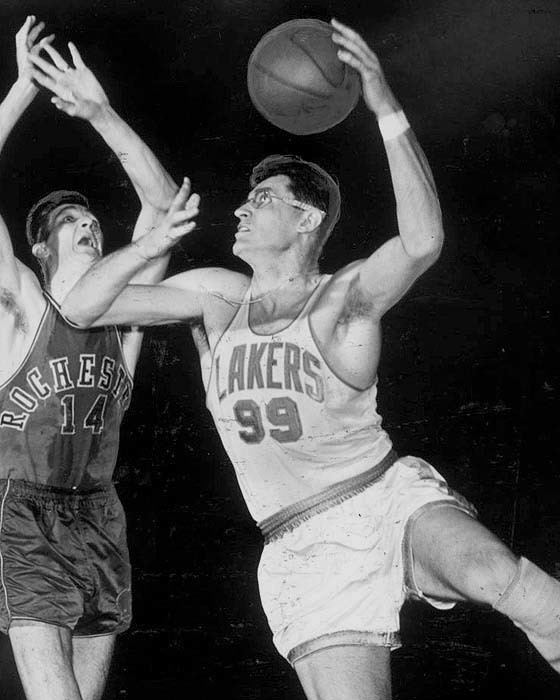George Mikan
Teams
Minneapolis Lakers - 1948-54, 1955-56
Playoffs
Appearances - 7 (1949,1950,1951,1952,1953,1954,1956)
Conference Finals - 6 (1949,1950,1951,1952,1953,1954)
NBA Finals - 5 (1949,1950,1952,1953,1954)
Championships - 5 (1949,1950,1952,1953,1954)
Awards and Honors
MVP - 0 (1949,1950,1951,1952,1954)
Finals MVP - 0 (1949,1950,1952,1953,1954)
All-NBA First Team - 6 (1949,1950,1951,1952,1953,1954)
Hall of Fame - 1959
*(actual in bold, deserved in italics)
All-Time Ranks
Points Per Game - #27
League Leads
Total Points (#1-1949,1950,1951, #2-1952,1953, #4-1954)
Points Per Game (#1-1949,1950,1951, #2-1952,1953, #4-1954)
Total Rebounds (#1-1953, #2-1951,1954, #3-1952)
Rebounds Per Game (#1-1952,1953, #2-1951,1954)
Field Goal Percentage (#2-1949, #3-1951, #5-1950)
George Mikan was the back-to-back College Basketball Player of the Year at DePaul in 1944 and 1945 and led the nation in scoring in his junior and senior seasons. He signed a contract with the Chicago American Gears of the NBL, a league that later merged into the NBA, but whose statistics are not considered official.
Chicago folded after that season, and Mikan was awarded to the Minneapolis Lakers, and he led them to the NBL championship that year. The next year, Minneapolis joined the BAA, who is considered the true forerunner of the NBA, where his statistics started to count toward the official totals, unlike his first two seasons.
During that season in the BAA, Mikan led all players by averaging 28.3 points per game, and he averaged 30.3 points in the playoffs to lead the Lakers to a championship win over the Washington Capitals.
The next season the BAA and NBL merged, officially becoming the NBA, but it was more of the same for Mikan, who led the league with 27.4 points per game, then upped that to 31.3 in the playoffs as the Lakers cruised to another title by beating Dolph Schayes and the Syracuse Nationals in the Finals.
Mikan led the league in scoring for the 3rd straight year in 1951, and also came in #2 in a new statistic called rebounds. The Lakers were on track to win a third straight title, but Mikan broke his leg in the first round of the playoffs, and played with the leg in a splint the rest of the way, and the Lakers fell in the Conference Finals, with Mikan still averaging 23.8 points per game with a very limited range of movement.
The next season, the league introduced a new rule designed to limit Mikan's effectiveness, widening the lane from 6 to 12 feet, forcing him farther away from the basket. He still averaged 23.8 points per game, a bit lower than before, but led the league with 13.5 rebounds per game, and again led the Lakers to a championship, beating the Knicks in 7 games.
He led the league in rebounding again the next year with a career high of 14.4 per game, and the Lakers beat the Knicks in the Finals for the second year in a row. He obviously started to slow down the next year, averaging only 18.1 points and 14.3 rebounds, but he still led the Lakers to a title, their 5th in 6 seasons.
The league adopted another new rule going into the next season, known as the shot clock, another rule that was meant to counteract the slow pace of play Mikan's style brought. Mikan chose to retire at that point, wanting to avoid any more serious injuries and to spend more time with his growing family. He did attempt a comeback midway through the next season, but he was not very effective with the new rule, averaging only 10.5 points and 8.3 rebounds that year.
Another new rule was introduced at that point, also due to Mikan. The league decided to ban goaltending, because Mikan would just camp out near the basket and wait until the ball was coming down, then tap it out of the cylinder. Without Mikan, the game of basketball wouldn't be anything like it is today.
Mikan had the shortest career of any player on this list, playing only 7 official NBA seasons, but he led the league in scoring 3 times, rebounding twice, and won 5 championships, failing only when he had a broken leg. The MVP and Finals MVP awards did not exist during his career, but it's likely that he would have won each of them 5 times. He was part of the very first Hall of Fame class back in 1959, and one of the greatest players of all time.



No comments:
Post a Comment